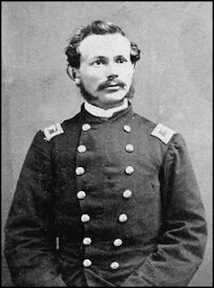The Kennesaw Line: Charles Harker and the “tornado of fire”

Newton’s right brigade was led forward on the fateful morning of June 27 by 27-year-old Brig. Gen. Charles Garrison Harker, a charismatic, handsome, and talented young New Jersey native. Harker had become a stand-out in the Army of the Cumberland in the battle of Chickamauga, where his brigade seemed to be everywhere at the right time and ended the battle holding the open spur out from the Snodgrass Family cabin against repeated assaults by the veterans of Longstreet’s Corps. Harker won promotion and now, as the junior brigadier in the army, he rode along his lines as his men advanced through the early morning mist toward the imposing line of breastworks from which could be seen the blue and white banners of Pat Cleburne’s division—a sign that it was going to be a rough fight.
Harker, mounted on a white horse, cut a knightly figure. As first artillery and then infantry opened fire on his command, he galloped along shouting encouragement to his column as it advanced—“exposed to a withering fire” at the double quick—trying to cover the space between the woods and the Confederate works as fast as they could. Men tumbled from the ranks at every step in what one participant called a “tornado of fire.”
As the lead regiment reached the abatis in front of the breastworks, the lead regiments—the 3rd Kentucky and 51st Illinois—reached the limits of human endurance and threw themselves on the ground with the brigade skirmishers, the 125th Ohio. With this, the column came to a grinding halt as the regiments piled into each other. The rear regiments took cover behind a swell in the ground a few yards in front of the rebel works.
John Shellenberger of the 64th Ohio in the middle of the column recalled, “Gen. Harker came riding up the slope from our rear. His cheeks were pale but his eyes were burning and his lips were compressed with a grim determination He passed around the right of the brigade and riding to the center along the crest, not more than 15 yards from the muzzles of the muskets behind the breastworks, he lifted his hat and called out; ‘Forward, men, and take these works.’ The brigade arose as one as ne man to follow his lead; his horse was just turning his nose toward the breastworks when the gallant Harker reeled in his saddle, stricken with a mortal wound. A bullet from the breastworks broke his right arm and penetrated his breast . . . . Just as Gen. Harker fell from his horse orders came from the rear to fall back, a movement which we immediately executed on the principle of ‘the devil take the hindmost.’”
Harker was taken back by his men to a field hospital, but he died that evening. His last thoughts still being of the assault, he inquired, “Did we take the mountain?” He died shortly after asking. Harker’s death was keenly felt; another talented young officer had been lost.
My 3g grandfather served with him. Was a great leader.
Certain names evoke vivid memories of battlefield tours. One of mine came at Kennesaw where I did my best to follow the route taken by the 125th Ohio on that fateful day. My great grandfather Warren Fishel and his brother Wesley were among the skirmishers mentioned above. Reading maps to the best of my ability I tracked from the bottom of the hill through the woods up toward the Confederate works. The first thing I saw when I emerged from the woods was the sign showing where Harker fell. You just don’t forget moments like that. May he rest in peace.
Wesley was seriously wounded at Kennesaw – ending his service in the war. The account of his wounding is recorded in Richard Baumgartner’s “Yankee Tigers” book.
My 2nd great granduncle, Benjamin F. Morse, 42nd Illinois, died with General Harker that day. A portion of his father’s notification letter reads, “Ben was very brave and none went farther to the front than he during the charge”.